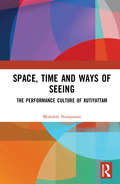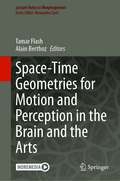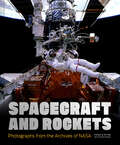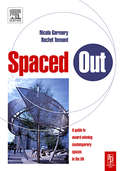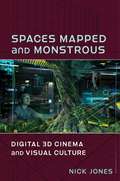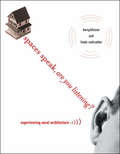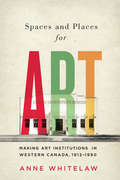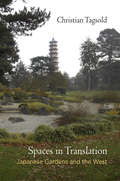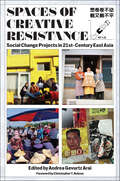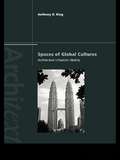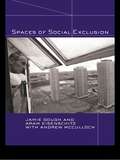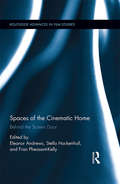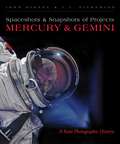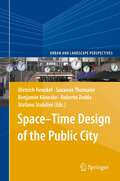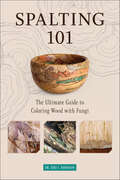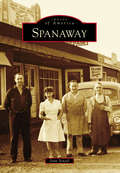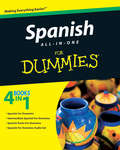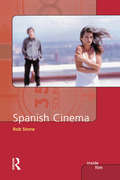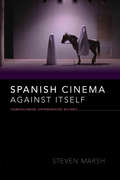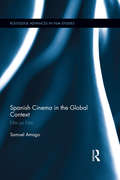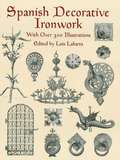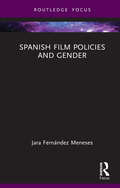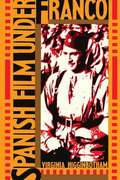- Table View
- List View
Space, Time and Ways of Seeing: The Performance Culture of Kutiyattam
by Mundoli NarayananThis volume explores the constitutive role played by space in the performance of Kutiyattam. The only surviving form of Sanskrit theatre, Kutiyattam is distinctive in terms of its performance conventions and its unique culture of extensive elaboration and interpretation. Drawing upon the concepts of phenomenology on the processes of perception, particularly on the works of Edmund Husserl, Martin Heidegger and Maurice Merleau-Ponty, it analyses the role of space in the communicative structures of performance of Kutiyattam and its contribution to the production of meaning in theatre, especially in the context of contemporary theatre. The book explores the theatrical event as a phenomenon that comes into existence through a triangular relationship among the ‘ways of being’ of the performers, the ‘ways of seeing’ of the audience, and the space which brings them together. Based on this formulation, Kutiyattam is approached as a ‘theatre of elaboration,’ made possible by the ‘intimate,’ ‘proximal’ ways of seeing of the audience, in the particular theatrical space of the kūttampalaṃs, the temple theatres, where Kutiyattam has customarily been performed for more than five centuries. This volume will be of great interest to scholars and researchers of cultural studies, theatre and performance studies, cultural anthropology, phenomenology and South Asian studies.
Space-Time Geometries for Motion and Perception in the Brain and the Arts (Lecture Notes in Morphogenesis)
by Alain Berthoz Tamar FlashThis book is based on a two-day symposium at the Paris Institute of Advanced Study titled "space-time geometries and movement in the brain and the arts". It includes over 20 chapters written by the leading scientists and artists who presented their related research studies at the symposium and includes six sections; the first three focus on space-time geometries in perception, action and memory while the last three focus on specific artistic domains: drawing and painting, dance, music, digital arts and robotics. The book is accompanied by a dedicated webpage including related images and videos. There is an ever-growing interest in the topics covered by this book. Space and time are of fundamental importance for our understanding of human perception, action, memory and cognition, and are entities which are equally important in physics, biology, neuroscience and psychology. Highly prominent scientists and mathematicians have expressed their belief that our bodies and minds shape the ways we perceive space and time and the physical laws we formulate. Understanding how the brain perceives motion and generates -bodily movements is of great significance. There is also growing interest in studying how space, time and movement subserve artistic creations in different artistic modalities (e.g., fine arts, digital and performing arts and music). This interest is inspired by the idea that artists make intuitive use of the principles and simplifying strategies used by the brain in movement generation and perception. Building upon new understanding of the spatio-temporal geometries subserving movement generation and perception by the brain we can start exploring how artists make use of such neuro --geometrical and neuro-dynamic representations in order to express artistic concepts and emotionally affect the human observers and listeners. Scientists have also started formulating new ideas of how aesthetic judgements emerge from the principles and brain mechanisms subserving motor control and motion perception.Covering novel and multidisciplinary topics, this advanced book will be of interest to neuroscientists, behavioral scientists, artificial intelligence and robotics experts, students and artists.
Spacecraft and Rockets: Photographs from the Archives of NASA (NASA)
by Nirmala Nataraj NASADiscover the remarkable NASA spacecraft that have captured our imaginations for decades.The rockets, rovers, satellites, and space stations that have charted courses into space are depicted in beautiful color images and paired with engaging annotations. Complete with a preface by Bill Nye, this collection perfectly captures the wonder and science of space exploration. From the earliest Saturn and Gemini missions through the modern-day Artemis and HALO ships, these extraordinary spacecraft will fascinate anyone intrigued by science, history, and the mysteries of the beyond. CELEBRATE INNOVATION: Spacecraft and Rockets features fascinating images accompanied by expert explanations of the history and science of space exploration. This book is a unique celebration of the technological advances that have taught us so much about the universe and our place amongst the stars. NASA-APPROVED SPACE BOOK: Bearing the official imprimatur of the legendary space agency, this stellar hardcover volume provides a guided tour through the history of NASA's most exciting innovations and inventions. FOR THE CURIOUS MIND: NASA’s beautifully documented space explorations inspire people of all ages, making this deluxe volume a wonderful gift for science enthusiasts, sci-fi fanatics, space-loving kids, and everyone in between.Perfect for: Science and technology buffs Space lovers, stargazers, and spacecraft geeks Sci-fi readers and anyone who dreams of one day going to space Teachers, students, and parents Photographers and photography enthusiasts
Spaced Out
by Rachel Tennant Nicola GarmoryThis beautifully illustrated guide celebrates some of the most significant award winning public spaces in major cities in the UK and Ireland over the last ten years.Dealing with a range of contemporary and innovating designed landscapes from urban spaces to public parks, this book focuses on those that have been awarded the highest design accolade from the Royal Institute of British Architects, The Royal Town andPlanning Institute, The Landscape Institute and The Civic Trust. Focusing on designs in ten major cities, and providing a snappy synopsis of each of the spaces in terms of its design statement, function, location, design team and award commentary, It illustrates tothe reader what makes 'good design' in the public realm, providing both information and inspiration.
Spaces Mapped and Monstrous: Digital 3D Cinema and Visual Culture (Film and Culture Series)
by Nick JonesDigital 3D has become a core feature of the twenty-first-century visual landscape. Yet 3D cinema is a contradictory media form: producing spaces that are highly regimented and exhaustively detailed, it simultaneously relies upon distortions of vision and space that are inherently strange.Spaces Mapped and Monstrous explores the paradoxical nature of 3D cinema to offer a critical analysis of an inescapable part of contemporary culture. Considering 3D’s distinctive visual qualities and its connections to wider digital systems, Nick Jones situates the production and exhibition of 3D cinema within a web of aesthetic, technological, and historical contexts. He examines 3D’s relationship with computer interfaces, virtual reality, and digital networks as well as tracing its lineage to predigital models of visual organization. Jones emphasizes that 3D is not only a technology used in films but also a tool for producing, controlling, and distorting space within systems of surveillance, corporatization, and militarization. The book features detailed analysis of a wide range of films—including Avatar (2009), Goodbye to Language (2014), Love (2015), and Clash of the Titans (2010)—demonstrating that 3D is not merely an augmentation of 2D cinema but that it has its own unique properties. Spaces Mapped and Monstrous brings together media archaeology, digital theory, and textual analysis to provide a new account of the importance of 3D to visual culture today.
Spaces Speak, Are You Listening?: Experiencing Aural Architecture
by Barry Blesser Linda-Ruth SalterHow we experience space by listening: the concepts of aural architecture, with examples ranging from Gothic cathedrals to surround sound home theater. We experience spaces not only by seeing but also by listening. We can navigate a room in the dark, and "hear" the emptiness of a house without furniture. Our experience of music in a concert hall depends on whether we sit in the front row or under the balcony. The unique acoustics of religious spaces acquire symbolic meaning. Social relationships are strongly influenced by the way that space changes sound. In Spaces Speak, Are You Listening?, Barry Blesser and Linda-Ruth Salter examine auditory spatial awareness: experiencing space by attentive listening. Every environment has an aural architecture. The audible attributes of physical space have always contributed to the fabric of human culture, as demonstrated by prehistoric multimedia cave paintings, classical Greek open-air theaters, Gothic cathedrals, acoustic geography of French villages, modern music reproduction, and virtual spaces in home theaters. Auditory spatial awareness is a prism that reveals a culture's attitudes toward hearing and space. Some listeners can learn to "see" objects with their ears, but even without training, we can all hear spatial geometry such as an open door or low ceiling.Integrating contributions from a wide range of disciplines—including architecture, music, acoustics, evolution, anthropology, cognitive psychology, audio engineering, and many others—Spaces Speak, Are You Listening? establishes the concepts and language of aural architecture. These concepts provide an interdisciplinary guide for anyone interested in gaining a better understanding of how space enhances our well-being. Aural architecture is not the exclusive domain of specialists. Accidentally or intentionally, we all function as aural architects.
Spaces and Places for Art: Making Art Institutions in Western Canada, 1912-1990
by Anne WhitelawWhen the Edmonton Museum of Arts opened in 1924 it was only the second art gallery in Canada west of Toronto. Spaces and Places for Art tells the story of the financial and ideological struggles that community groups and artist societies in booming frontier cities and towns faced in establishing spaces for the cultivation of artistic taste. Mapping the development of art institutions in western Canada from the founding of the Winnipeg Art Gallery in 1912 to the 1990s heyday of art museums in Manitoba, Saskatchewan, Alberta, and British Columbia, Anne Whitelaw provides a glimpse into the production, circulation, and consumption of art in Canada throughout the twentieth century. Initially dependent on paintings loaned from the National Gallery of Canada, art galleries across the western part of the country gradually built their own collections and exhibitions and formed organizations that made them less reliant on institutions and government agencies in Ottawa. Tracing the impact of major national arts initiatives such as the Massey Commission, the funding programs of the Canada Council, and the policies of the National Museums Corporation, Whitelaw sheds light on the complex relationships between western Canada and Ottawa surrounding art. Building on extensive archival research and in-depth analysis of government involvement, Spaces and Places for Art is an invaluable explanation of the roles of cultural institutions and cultural policy in the emergence of artistic practice in Canada.
Spaces and Places for Art: Making Art Institutions in Western Canada, 1912-1990 (McGill-Queen's/Beaverbrook Canadian Foundation Studies in Art History #37)
by Anne WhitelawWhen the Edmonton Museum of Arts opened in 1924 it was only the second art gallery in Canada west of Toronto. Spaces and Places for Art tells the story of the financial and ideological struggles that community groups and artist societies in booming frontier cities and towns faced in establishing spaces for the cultivation of artistic taste. Mapping the development of art institutions in western Canada from the founding of the Winnipeg Art Gallery in 1912 to the 1990s heyday of art museums in Manitoba, Saskatchewan, Alberta, and British Columbia, Anne Whitelaw provides a glimpse into the production, circulation, and consumption of art in Canada throughout the twentieth century. Initially dependent on paintings loaned from the National Gallery of Canada, art galleries across the western part of the country gradually built their own collections and exhibitions and formed organizations that made them less reliant on institutions and government agencies in Ottawa. Tracing the impact of major national arts initiatives such as the Massey Commission, the funding programs of the Canada Council, and the policies of the National Museums Corporation, Whitelaw sheds light on the complex relationships between western Canada and Ottawa surrounding art. Building on extensive archival research and in-depth analysis of government involvement, Spaces and Places for Art is an invaluable explanation of the roles of cultural institutions and cultural policy in the emergence of artistic practice in Canada.
Spaces in Translation: Japanese Gardens and the West
by Christian TagsoldOne may visit famous gardens in Tokyo, Kyoto, or Osaka—or one may visit Japanese-styled gardens in New York, San Francisco, Philadelphia, Berlin, London, Paris, São Paulo, or Singapore. We often view these gardens as representative of the essence of Japanese culture. Christian Tagsold argues, however, that the idea of the Japanese garden has less do to with Japan's history and traditions, and more to do with its interactions with the West.The first Japanese gardens in the West appeared at the world's fairs in Vienna in 1873 and Philadelphia in 1876 and others soon appeared in museums, garden expositions, the estates of the wealthy, and public parks. By the end of the nineteenth century, the Japanese garden, described as mystical and attuned to nature, had usurped the popularity of the Chinese garden, so prevalent in the eighteenth century. While Japan sponsored the creation of some gardens in a series of acts of cultural diplomacy, the Japanese style was interpreted and promulgated by Europeans and Americans as well. But the fashion for Japanese gardens would decline in inverse relation to the rise of Japanese militarism in the 1930s, their rehabilitation coming in the years following World War II, with the rise of the Zen meditation garden style that has come to dominate the Japanese garden in the West.Tagsold has visited over eighty gardens in ten countries with an eye to questioning how these places signify Japan in non-Japanese geographical and cultural contexts. He ponders their history, the reasons for their popularity, and their connections to geopolitical events, explores their shifting aesthetic, and analyzes those elements which convince visitors that these gardens are "authentic." He concludes that a constant process of cultural translation between Japanese and Western experts and commentators marked these spaces as expressions of otherness, creating an idea of the Orient and its distinction from the West.
Spaces of Creative Resistance: Social Change Projects in Twenty-First-Century East Asia
by Andrea Gevurtz Arai Yuyu Liu Yue Wu Yeonjung Ahn Miriam Timson Hyein Chae Chor-See Chan Summer Xuan Dai Liling Huang Jeff Hou Hidehiko Ishibashi Hsiu Fan Lin Yumi Matsubara Keisuke Sugano Jinyue XuSpaces of Creative Resistance: Social Change Projects in Twenty-First-Century East Asia brings together an exciting cross-regional interdisciplinary group of scholars, scholar activists, artists, and others for a collection that addresses the last two decades' hollowing out of social connections, socioeconomic income gaps, and general precarity of life in East Asian societies. Written by authors from China, Japan, South Korea, Taiwan, and Hong Kong, each chapter is focused on people making a difference together in socially sustainable ways, particularly in the areas of gender, labor, and environments—both built and natural. These projects all constitute acts of creative resistance to neoliberal development, and each act of creative resistance demonstrates how individuals and communities across East Asia are making new worlds and lifeways in the small and everyday. Taking on larger political and economic forces that affect their lives and communities, each project and group of individuals featured here is focused on making more liveable presents and more possible futures.
Spaces of Global Cultures: Architecture, Urbanism, Identity (Architext)
by Anthony KingThis book brings together a series of new and historical case studies to show how different phases of globalization are transforming the built environment. Taking a broad interdisciplinary approach, the author draws on sociological, geographical, cultural and postcolonial studies to provide a critical account of the development of three key concepts: global culture, post colonialism, and modernity. Subsequent case studies examine how global economic, political and cultural forces shape the forms of architectural and urban modernity in globalized suburbs and spaces in major cities worldwide. The first book to combine global and postcolonial theoretical approaches to the built environment and to illustrate these with examples, Spaces of Global Cultures argues for a more historical and interdisciplinary understanding of globalization: one that places material space and the built environment at the centre and calls for new theories to address new conditions.
Spaces of Social Exclusion
by Jamie Gough Aram Eisenschitz Andrew McCullochTo varying extents in developed countries a minority of the population suffers from deprivation. Britain’s Labour government in particular has sought to deal with this through the notion of 'social exclusion', and similar ideas have been developed in other countries. This important text explores the various forms of this contemporary economic and social disadvantage and, in particular, investigates its social and spatial causes and the role of space in policies addressing disadvantage. Arranged in three distinct parts, it: introduces contemporary and historical conceptualizations of social exclusion and poverty analyzes social exclusion’s origins by examining the different spheres of disadvantage and their relations discusses strategies for overcoming social exclusion, and analyzes policy ideas from across the political spectrum. This book is the first to systematically analyze the role of geography in poverty and social exclusion, and deals with the roles of ‘globalization’ and localism. Though its main focus is Britain, it investigates similarities and differences in other developed countries. Spaces of Social Exclusion is a key text for researchers and students throughout the social sciences, social policy, human geography and urban studies, as well as policy makers and practitioners in social and urban policy.
Spaces of the Cinematic Home: Behind the Screen Door (Routledge Advances in Film Studies #42)
by Stella Hockenhull Eleanor Andrews Fran Pheasant-KellyThis book examines the ways in which the house appears in films and the modes by which it moves beyond being merely a backdrop for action. Specifically, it explores the ways that domestic spaces carry inherent connotations that filmmakers exploit to enhance meanings and pleasures within film. Rather than simply examining the representation of the house as national symbol, auteur trait, or in terms of genre, contributors study various rooms in the domestic sphere from an assortment of time periods and from a diversity of national cinemas—from interior spaces in ancient Rome to the Chinese kitchen, from the animated house to the metaphor of the armchair in film noir.
Spaceshots and Snapshots of Projects Mercury and Gemini: A Rare Photographic History
by John Bisney J. L. PickeringThe race to space between the United States and the Soviet Union captured the popular imagination. On April 12, 1961, the USSR launched cosmonaut Yuri Gagarin on a one-orbit flight, making him the first human in space. Three weeks later, American astronaut Alan B. Shepard Jr. flew 116 miles above Earth before splashing down in the Bahamas. Over the next twenty years astronauts emerged as national heroes.This book tells the story of the people and events of Projects Mercury and Gemini with hundreds of unpublished and rare photographs—both color and black-and-white. Unlike other publications, which illustrate the space race with well-known and easily accessible images, this history draws from the authors&’ private library of over one hundred thousand (and growing) high-quality photos of the early US manned space program. Collected over a lifetime from public and private sources—including NASA archives, fellow collectors, retired NASA and news photographers, and auction houses—the images document American space missions of the Cold War era more comprehensively than ever before. Devoting a chapter to each flight, the authors also include detailed descriptions, providing new insight into one of America&’s greatest triumphs.
Space–Time Design of the Public City
by Dietrich Henckel Benjamin Könecke Stefano Stabilini Roberto Zedda Susanne ThomaierTime has become an increasingly important topic in urban studies and urban planning. The spatial-temporal interplay is not only of relevance for the theory of urban development and urban politics, but also for urban planning and governance. The space-time approach focuses on the human being with its various habits and routines in the city. Understanding and taking those habits into account in urban planning and public policies offers a new way to improve the quality of life in our cities. Adapting the supply and accessibility of public spaces and services to the inhabitants' space-time needs calls for an integrated approach to the physical design of urban space and to the organization of cities. In the last two decades the body of practical and theoretical work on urban space-time topics has grown substantially. The book offers a state of the art overview of the theoretical reasoning, the development of new analytical tools, and practical experience of the space-time design of public cities in major European countries. The contributions were written by academics and practitioners from various fields exploring space-time research and planning.
Spalting 101: The Ultimate Guide to Coloring Wood with Fungi
by Dr. Seri RobinsonA step-by-step guide to DIY spalting—harnessing fungi to create spectacular colors and lines in woodLeads beginners to success and offers spalting veterans fascinating info to improve their workWhether spalting wood in your yard, your bathroom, or a lab, save time and frustration
Spanaway
by Jean SenselAround 1840, the British Hudson Bay Company set up a cattle ranch on the shore of a haunted lake that local tribes called Spa'nu-we. A hunting trail through the Cascade Mountains crossed at Spa'nu-we with another pathway running to Puget Sound from the sleeping volcano Tu'qobu (Tacoma). Both trails became roads and railways that drew settlers to Spa'nu-we's rich prairie and abundant water. Thus began decades of conflict--often armed--with the evolving town of Spanaway caught in regional and national turmoil. Because of its strategic location, Spanaway homesteads were used as temporary military outposts during two wars. Hundreds of family farms were lost forever when they were condemned to form Camp Lewis. Spanaway's resort "on the most beautiful lake in a land of lakes" has drawn controversial rallies, lawsuits, and political battles. Spanaway, still buffeted by political winds, continues today as a regional playground and transportation hub.
Spanish All-in-One For Dummies
by The Experts at For DummiesA value-packed guide to speaking, reading, and writing in Spanish Spanish All-in-One For Dummies is the first Dummies All-in-One title in the foreign language category–nearly 800 pages of expert instruction to help people master Spanish basics and beyond. This comprehensive volume features content from all For Dummies Spanish language instruction titles, including Spanish For Dummies, Intermediate Spanish For Dummies, Spanish Verbs For Dummies, and Spanish For Dummies Audio Set. The book's audio CD provides readers with an effective tool to help them start speaking Spanish from day one. Plus, the practical exercises give readers greater confidence in communicating in Spanish, whether traveling or in business.
Spanish Cinema (Inside Film)
by Rob StoneFrom the surrealist films of Luis Buñuel to the colourful melodramas of Pedro Almodóvar, Spain has produced a wealth of exciting and distinctive film-makers who have consistently provided a condoning or dissenting eye on Spanish history and culture. For modern cinema-goers, it has often been the sexually-charged and colourful nature of many contemporary Spanish films, which has made them popular world-wide and led directors and stars such as Almodóvar, Banderas and Penélope Cruz to be welcomed by Hollywood. Using original interview material with Spanish Cinema luminaries such as Carlos Saura, Julio Medem, Imanol Uribe and Elías Querejeta, Rob Stone charts a history of Spanish Cinema throughout the turbulent Francoist years and beyond. The book aims to provide a broad introduction to Spanish Cinema, the nine chapters divided into four types: chapters on Spanish Cinema during the Dictatorship and following the transition to democracy survey current debate and opinion while tracing the development of themes and film movements throughout those periods. chapters on early Spanish cinema and Basque cinema present vital and fascinating aspects of Spanish cinema that have previously been ignored chapters on childhood in Spanish cinema, and sex and the new star system offer new pathways into the study of Spanish cinema chapters on Carlos Saura, Elías Querejeta and Julio Medem offer specific case studies of film-makers who are emblematic of different periods in Spanish cinema and, indeed, Spanish history As with other titles in the Inside Film series, the book is comprehensively illustrated with representative stills and has a thorough bibliography, index and list of resources.
Spanish Cinema Against Itself: Cosmopolitanism, Experimentation, Militancy (New Directions in National Cinemas)
by Steven Marsh“An extraordinary philosophical exploration of the political potential and continued political commitment of cinema today . . . An essential read.” —Patricia Keller, Associate Professor of Spanish and Comparative Literature, Cornell UniversitySpanish Cinema Against Itself maps the evolution of Spanish surrealist and politically committed cinematic traditions from their origins in the 1930s—with the work of Luis Buñuel and Salvador Dalí, experimentalist José Val de Omar, and militant documentary filmmaker Carlos Velo—through to the contemporary period. Framed by film theory this book traces the works of understudied and non-canonical Spanish filmmakers, producers, and film collectives to open up alternate, more cosmopolitan and philosophical spaces for film discussion. In an age of the post-national and the postcinematic, Steven Marsh’s work challenges conventional historiographical discourse, the concept of “national cinema,” and questions of form in cinematic practice.“In this exhilarating counter-history of experimental filmmaking in Spain, Steven Marsh takes up the politics of form, the trouble with film history, and the theoretical potential of haunting, discontinuity, and absence . . . Spanish Cinema Against Itself is an important intervention in Spanish film studies and, indeed, in the scholarship on world cinema.” —Rosalind Galt, Professor of Film Studies, King’s College London
Spanish Cinema against Itself: Cosmopolitanism, Experimentation, Militancy (New Directions in National Cinemas)
by Steven MarshSpanish Cinema against Itself maps the evolution of Spanish surrealist and politically committed cinematic traditions from their origins in the 1930s—with the work of Luis Buñuel and Salvador Dalí, experimentalist José Val de Omar, and militant documentary filmmaker Carlos Velo—through to the contemporary period. Framed by film theory this book traces the works of understudied and non-canonical Spanish filmmakers, producers, and film collectives to open up alternate, more cosmopolitan and philosophical spaces for film discussion. In an age of the post-national and the postcinematic, Steven Marsh's work challenges conventional historiographical discourse, the concept of "national cinema," and questions of form in cinematic practice.
Spanish Cinema in the Global Context: Film on Film (Routledge Advances in Film Studies #26)
by Samuel AmagoAcross a broad spectrum of media, markets, and national contexts, self-reflexivity continues to be a favored narrative mode with wide ranging functions. In this book Amago argues that, in addition to making visible industry and production concerns within the film text, reflexive aesthetics have a cartographic function that serves to map the place of a film (geographic and cultural) within the global cinemascape, and thus to bring into sharper relief images of the national. Focusing on films in the contemporary Spanish context that in some way reflect back on themselves and the processes of their own production, that purposefully blur the distinction between reality and fiction, or that draw attention to the various modes of cinematic exhibition and reception, Amago proposes ways in which these movies can be employed to understand Spanish national cinemas today as imbedded within a dynamic global system.
Spanish Decorative Ironwork
by Luis LabartaOver 300 outstanding illustrations -- thoughtfully selected and excellently reproduced -- depict ornate altar screens, doors, chandeliers, balcony railings, candelabra, tombstone crosses, pulpits, gates, window screens, and more. Brief captions identify the types, origins, and dates of pieces in this excellent collection for artists, interior designers, craftspeople, and lovers of antiques.
Spanish Film Policies and Gender (Routledge Focus on Media and Cultural Studies)
by Jara Fernández MenesesThis book provides a comprehensive cultural and historical account of the key film policies put into place by the Spanish state between 1980 and 2010 through a gendered lens, framing these policies within the wider context of European film legislation.Departing from the belief that there is no such thing as an objective and value-neutral approach to policy analysis because our society is organised around gender, this volume builds upon Pierre Bourdieu’s theory of field to propose that film policies do not emerge in a vacuum because they respond to different demands from those agents involved in the field of the Spanish cinema. By so doing, it critically assesses how these policies have come into being, by whom, in response to what interests, how they have shaped the Spanish film industry, and how far and in what ways they have tackled gender inequality in the Spanish film industry.This book will be of great interest to scholars and students of Spanish cinema, gender studies, film industry studies, film policy, and feminist film studies.
Spanish Film under Franco
by Virginia HigginbothamHow does a totalitarian government influence the arts, and how do the arts respond? Spanish Film Under Franco raises these important questions, giving English speakers a starting point in their study of Spanish cinema. After a brief overview of Spanish film before Franco, the author proceeds to a discussion of censorship as practiced by the Franco regime. The response of directors to censorship-the "franquista aesthetic," or "aesthetic of repression," with its highly metaphorical, oblique style-is explored in the works of Luis Buñuel, Carlos Saura, Juan Antonio Bardem, Luis García Berlanga, and other important directors. Virginia Higginbotham combines historical perspective with detailed critical analysis and interpretation of many famous Franco-era films. She shows how directors managed to evade the censors and raise public awareness of issuesrelating to the Spanish Civil War and the repressions of the Franco regime. Film has always performed an educational function in Spain, reaching masses of poor and uneducated citizens. And sometimes, as this study also reveals, Spanish film has been ignored when the questions it raised became too painful or demanding. The author concludes with a look at post-Franco cinema and the directions it has taken. For anyone interested in modern Spanish film, this book will be essential reading.
